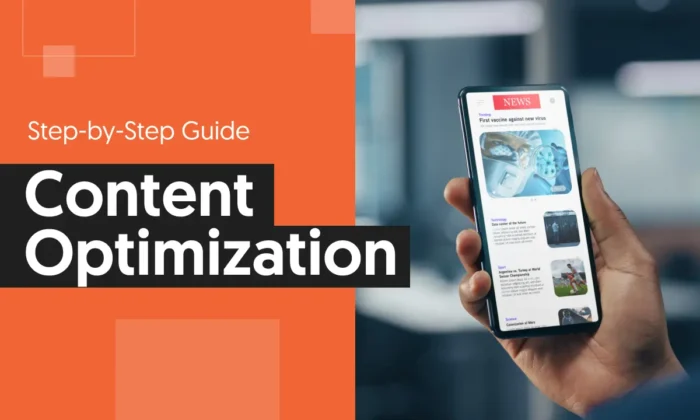

Is your content not getting the results you want to see?
Unfortunately, in today’s ultra-competitive, crowded SERPs, creating great content isn’t enough. You need to optimize it effectively if you want it to rank and sell.
That doesn’t just mean optimizing your content for Google. You also need to optimize it for readability and conversions.
Confused? This is the guide for you. I’ll show you a step-by-step guide for optimizing your content.
We’ll cover:
- What content optimization is
- The benefits of content optimization
- How to optimize your content for SEO
- How to optimize your content for readability and style
- How to optimize your content for conversions
- Common optimization mistakes
- How to measure and analyze content performance
Ready? Let’s begin.
Key Takeaways
- Content optimization is the practice of updating and improving content to increase its chances of ranking in Google and other search engines.
- Content optimization can increase your rankings, but it can also earn you more backlinks, increase leads, and build more trust with your audience.
- On-page content optimizations include adding relevant keywords, matching search intent, and adding more internal links.
- Your content optimization efforts should improve the readability and style of your text, delivering a better experience for readers and making it easier for search engines to understand.
- Content should also be optimized for conversions by targeting commercial keywords and improving your content’s calls to action.
- There are several common content optimization mistakes you should avoid, including keyword stuffing, neglecting the user experience, and ignoring mobile optimization.
What Is Content Optimization?
Content optimization is the practice of updating and improving your content so it has the best possible chance of achieving its goals. That goal could be ranking in Google, but it could also be converting readers into customers or acquiring backlinks. In many cases, it’s a combination of several of these metrics.
Benefits of Content Optimization
From an SEO standpoint, content optimization is essential if you want to rank. You might have written the best article in the world from a reader’s perspective. But if you don’t optimize content for Google, it won’t rank.
Getting your content to rank in Google has many additional benefits. These include:
- Earning backlinks
- Growing your audience
- Increasing leads
- Building trust
Optimizing your content for readability improves audience engagement and helps your brand build trust with readers. It can also help position your brand as an authority. It’s a lot easier to trust a brand that clearly invests time into content creation than one that produces barely legible content.
Optimizing content for conversions is critical if you want to squeeze as much money out of your efforts as possible. You’ll never write the best-converting piece of copy the first time around, which is why tweaking your headings, targeting new keywords, and improving your CTA (call to action) is vital.
In addition, your conversion goals may change over time, so you want to make sure your content adapts to them.
How to Optimize Content for SEO
Improving your content’s rankings is the primary reason for content optimization. So let’s start by looking at how to optimize content for SEO.
Keyword Research
Optimizing content for SEO starts with keyword research. You need to make sure you’re targeting a keyword that:
- Has traffic potential
- You can rank for
Ubersuggest is one of the best ways to find suitable keywords. Use the Keyword Ideas tool to enter a seed keyword and get a list of relevant keywords along with their potential volume and SEO difficulty.
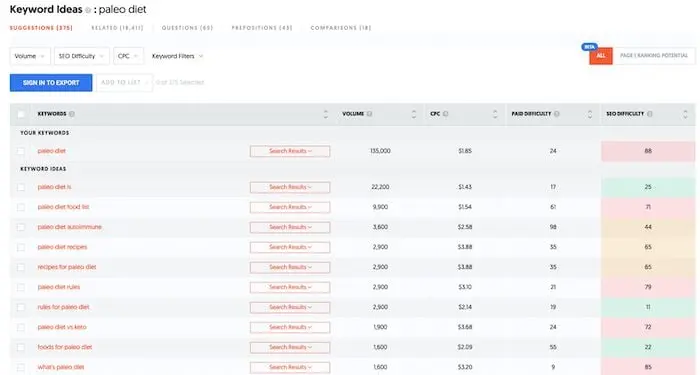
You’ll want to choose the keyword that best represents your content, but also has a decent amount of traffic and a realistic keyword difficulty. If your site is new, there’s little point in optimizing for a term with an SEO difficulty in excess of 50. You’re fighting an uphill battle from the start.
You can also use this tool to find semantically related keywords that you should also use in your content. The more of these topics you include, the easier it will be for search engines to understand what your content is about.
Competitor Research
Once you have your keywords, it’s time to see what’s currently ranking on Google. In particular, you need to make sure your content aligns with what users are searching for. Luckily, that’s pretty easy to understand by analyzing each of the top-ranking results aka your competitor’s keyword rankings. Open them up and look at:
- The page type: Is it a blog post, an e-commerce page, or something else?
- The format: Is it a listicle, a how-to guide, or a review?
- The content: Do the top pages write about the same thing? Do they all come at the topic in a similar way?
Don’t try to be unique here. If Google is prioritizing blog posts over e-commerce pages for a certain query, then you need to create a blog post. The same goes for the content’s format and angle. Understand what Google wants and then deliver it.
Don’t just create cookie-cutter content, however. By analyzing the content for each page, you can see what’s missing and find places to add your own perspective.
On-Page Optimization
As you edit your content to align with Google’s preferred format, integrate the keywords you found using Ubersuggest.
You should include keywords in your page’s:
- Title
- Meta description
- H1 tag
- Image alt tags
- URL
You should naturally include your keywords throughout your copy to create SEO-optimized content.
Be careful of keyword stuffing, however. This is when you add so many keywords that the copy becomes over-optimized and hard to read. Not only does this provide a terrible user experience for your readers—who have to trip over the phrase every other sentence—but it will also get your site penalized by Google.
Don’t forget about internal links, either—they are criminally overlooked when it comes to content optimization. The more internal links you have on your site, the easier search bots can crawl it, and the more link authority will be passed between pages.
Internal linking also makes it easier for humans to navigate your site.
When optimizing a page, list all related pages on your site and find a way to link to them naturally in the copy. Then, go to each of these pages and make sure there is a link back to the page you’re optimizing.
How to Optimize Content for Style and Readability
Next, let’s look at how to improve your content from a human perspective. There’s no point in having an article that ranks well if users aren’t going to spend time reading it. At the same time, the more readers engage with your content, the better your rankings will be.
Improve Your Content’s Structure
Does your content look like a stream of consciousness, or is it carefully structured and easy to scan? If it’s more the former than the latter, you’ll need to reassess its structure.
Luckily, improving your content’s structure and increasing visual comprehension is easy:
- Add a table of contents at the start of the post
- Use bullet points to break up paragraphs
- Use headings and subheadings
- Add a takeaway sentence at the end of each section
Add Images and Other Media
Another way to improve your content’s structure is to add images and videos. Make sure the images are relevant and add context — in other words, limit the use of stock photos.
When you add images, improve your SEO by adding keyword-rich descriptive titles and alt tags to all of them. But again, be careful of keyword-stuffing.
Imagine I’m writing an article about choosing the right-sized moving truck and I want to include the following image:

Here’s a bad example of a title and description for this image.
Title: truck.png
Alt text: moving truck
Neither is particularly descriptive, despite including the keyword.
Here’s another bad example:
Title: moving truck.png
Alt text: moving truck image to find the right-sized moving truck
This is a classic example of keyword-stuffing. The alt text has too many keywords that it becomes unreadable.
Here’s what the title and alt text should look like:
Title: loading-moving-truck.png
Alt text: Loading a moving truck with black crates
Both the title and alt text accurately describe the image and include a relevant keyword once. Were someone to use a screen reader on this image, they’d be able to imagine what it looks like fairly easily.
Optimize for Readability
If users are spending their valuable time reading your content, make sure it’s a great experience.
There are lots of ways to improve your writing:
- Use a spellchecker to eliminate errors.
- Eliminate fluff like cliches and words like “that.”
- Use short sentences and write as you speak.
- Vary sentence length, so your copy isn’t monotonous.
- Write in an engaging tone.
Tools like Hemingway, Grammarly, and Writer are fantastic additions to your arsenal when it comes to improving your content’s readability.
Grammarly and Writer are writing assistants that will improve your spelling, grammar, and clarity. Think of them as spell checkers on steroids.
So not only will they highlight spelling mistakes and suggest places to add an Oxford comma, they’ll also offer style and tone suggestions.
In the example below, for instance, Grammarly suggests you replace “very helpful” with “constructive” because it’s a stronger and more concise alternative.
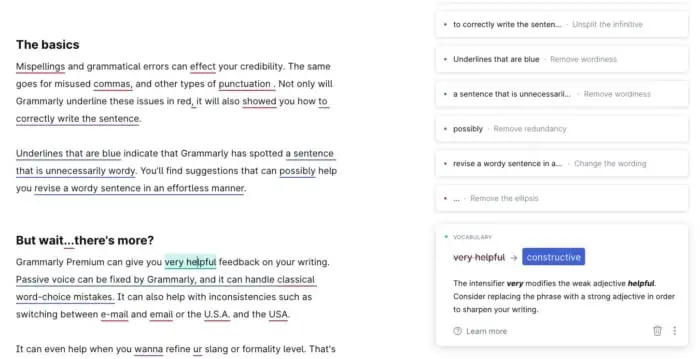
Hemingway can also improve your grammar, but it excels in suggesting ways to make your copy bolder, more concise, and more engaging.
For instance, it highlights hard-to-read sentences, suggests simpler phrases, and gives your content a readability score.
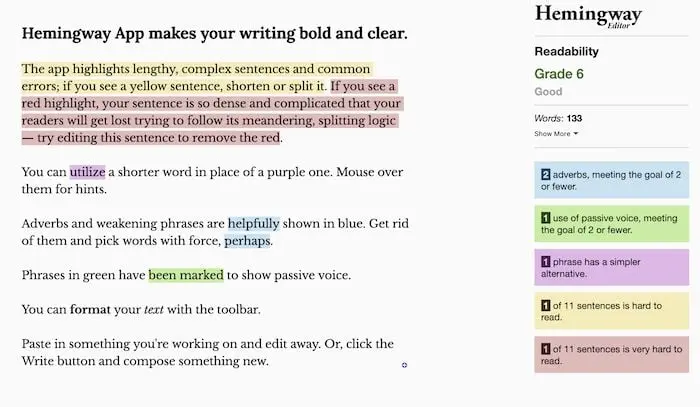
How to Optimize Content for Conversions
Good content converts, but here’s how to create great content that converts.
Target Commercial Keywords and Topics
Choosing the right topic is the first step to driving sales with content. Just as you did when optimizing for SEO, make sure the keyword you’re targeting has a high user intent. You can use Ubersuggest to analyze keywords, but the following sources are also a great way to find suitable topics:
- Quora
- Alexa
- Buzzsumo
Bonus points if your product or service is relevant to the keywords. For instance, we can use Quora’s related questions tab to find a great list of blog topics for a company that sells kitchen knives.

“Is a good chef knife worth it?” and “what is the best type of kitchen knife?” are great, high-intent information-based topics that may be easier to rank for than a more general keyword like “best kitchen knife”.
Be Persuasive
There are several persuasive strategies you can use to make your copy more enticing. These include:
- Add social proof to show real people **** your product.
- Write in a friendly tone to get on your reader’s good side.
- Show your product works through case studies.
If you can combine several of these points in a single piece of content, even better. Take this blog post about e-commerce website security by BigCommerce as an example:
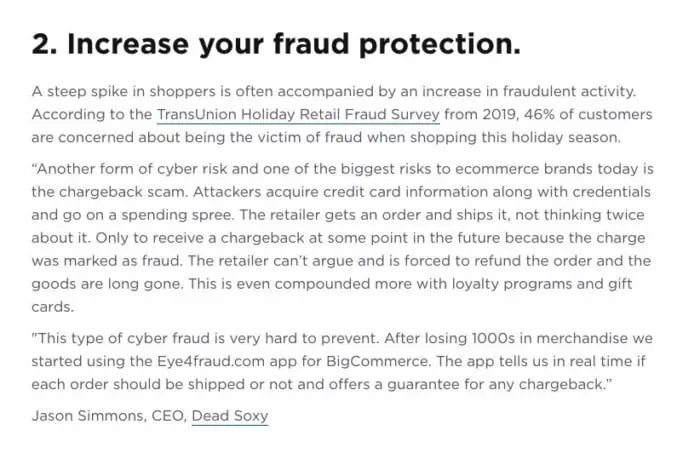
In a section about fraud protection, they include a quote from a store owner explaining how a specific app on the BigCommerce platform helped them reduce chargebacks after losing thousands of dollars in merchandise.
Not only does it show that BigCommerce apps work, it also proves they are used by real retailers.
Optimizing Calls-to-Action (CTAs)
Strategically placing calls to action in your copy is an important content optimization strategy.
Every piece of high-converting content features at least one call to action (CTA) like:
- A free trial
- An email sign-up form
- Links to relevant products
CTAs typically appear at the end of a landing page or blog post, but they don’t have to. Buffer, for instance, includes an email signup CTA in the middle of its blog post:
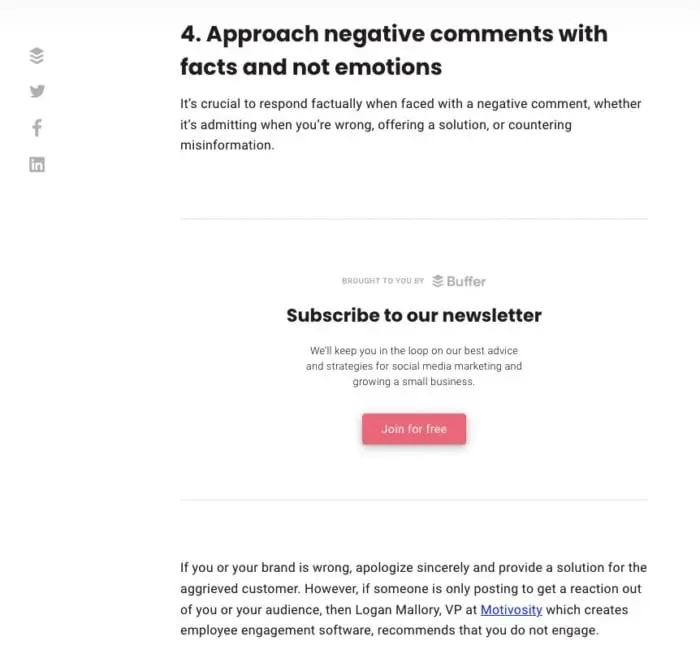
Note how hard it is to miss and how far down it is on the page. That’s on purpose.
If you’ve read this far, there’s a good chance you enjoy the content and will want to be updated whenever a new post goes live. This CTA wouldn’t be half as effective if it was used at the start of the article.
You should also note the language Buffer uses in the example above. Both the headline and the CTA button start with a verb that commands the reader to take action. They also explain the benefit of signing up (to get the best advice and strategies) and confirm that there’s no cost.
Don’t worry if your CTA isn’t converting hundreds of users at first. You can use tools like heatmaps and A/B tests to measure the impact of your CTA and test different versions.
What Are Common Content Optimization Mistakes to Avoid?
Now that we’ve looked at the three major methods you can use to optimize your content, let’s cover the most common content optimization mistakes I see time and again.
Keyword Stuffing
If you want to know how to optimize content for SEO the wrong way, keyword stuffing would probably be at the top of the list.
As mentioned before, this spammy tactic involves unnaturally adding loads of keywords to your content so it reads something like the following:
“The best content optimization techniques are the ones that make content optimization easy. In this content optimization article, I’ll feature ten content optimization tools to streamline your content optimization efforts.”
See how awful that is to read? Keyword stuffing doesn’t just turn readers off, though. Google will penalize your site for it, too. In short, it has no place in content marketing.
Neglecting User Experience
A common mistake is to focus all your content optimization strategies on pleasing Google.
But in reality, it starts with your reader. You need to optimize for humans first as Google’s algorithm gets more advanced. Improving the quality, depth, and readability of your content is a great start, but make sure your website offers a fantastic experience, too.
In particular, make sure your site’s Core Web Vitals are on point. These are three metrics Google uses to measure your site’s speed, visual stability and interactivity.
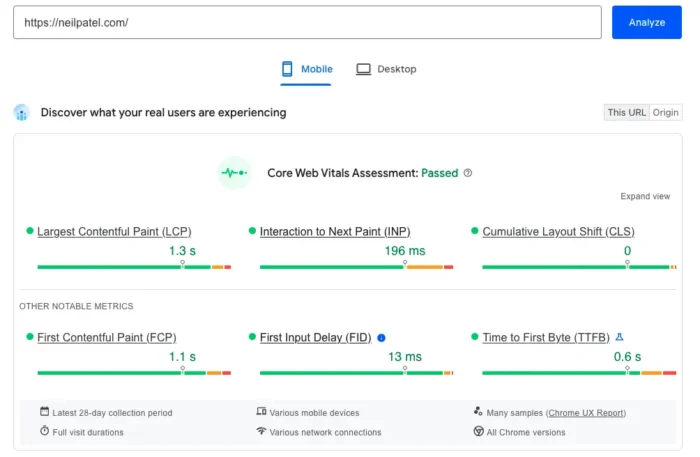
Use Google’s PageSpeed Insights tool to measure your site’s Core Web Vitals and get a list of ways you can improve them.
Focusing on Quantity over Quality
Regularly publishing new content is crucial for long-term SEO success. But you don’t want to sacrifice quality for quantity.
It’s vital to make sure you spend enough time optimizing your content to attract backlinks, improve social shares, and establish brand authority.
There are a couple of elements you can add to your existing content that will make a link and social share magnet:
- Original research
- Expert quotes or advice
- A controversial angle or opinion
- Unique examples
Try to include at least one of these features in every bit of content you create. That way, you’ll have a great chance of standing apart from the rest of the content on page one.
Ignoring Mobile Optimization
A big part of content optimization in SEO is making sure your site performs exceptionally on smartphones. Why? Because over half of web traffic comes from mobile devices.
Google also uses mobile-first indexing, which means its crawlers prioritize indexing the mobile version of your website over the desktop version. In other words, it could hurt your rankings if your site isn’t mobile-optimized.
Start by making sure your site has a mobile-responsive design or a separate mobile version. Then use the PageSpeed Insights tool to measure your site’s mobile performance and find ways to improve it.
Common strategies include:
- Minimizing HTTP requests
- Reducing the size of JavaScript files
- Optimizing image sizes
- Using a CDN
Measuring and Analyzing Content Performance
If you’re not measuring how your content performs, then you’re never going to create the most effective piece of SEO-optimized content possible. You need to gather baseline metrics to understand what’s wrong with your content and how you can improve it.
Setting Key Performance Indicators (KPIs)
Start measuring the performance of your content optimization strategy by establishing goal-aligned KPIs for your content. What do I mean by goal-aligned? Well, if you’re seeing to increase top-of-funnel visibility, then you might want to track:
- Impressions
- Organic traffic
- SERP rankings
But if your goal is to drive conversions with your organic content, then conversion rate and revenue may be more suitable metrics.
You’ll want to use an analytics platform like Google Analytics to track website-related metrics, but make sure you choose an SEO-focused platform like Ubersuggest if you’re tracking rankings.
Using Analytics Tools
There are plenty of analytics tools that can augment your content optimization strategies. Some can measure the KPIs we discussed above, some can track how users engage with your content, and some can help you find ways to improve your on-page optimization efforts.
Tools like Google Analytics, Ubersuggest, and Ahrefs can help you measure the amount of organic traffic your content receives, how many keywords it’s ranking for, and how these metrics change over time.
Behavior analytics tools like Hotjar are a fantastic way to improve your content’s conversion rate. Hotjar provides heatmaps and session recordings, so you can see where readers focus their attention, what they click on, and how far they scroll.
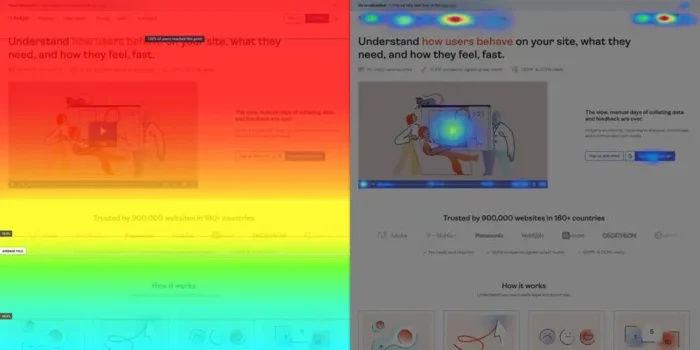
Finally, there are on-page optimization tools like Frase, Clearscope, and Surfer. These platforms reverse engineer Google’s first-page results and provide on-page optimization recommendations to help you beat the competition.
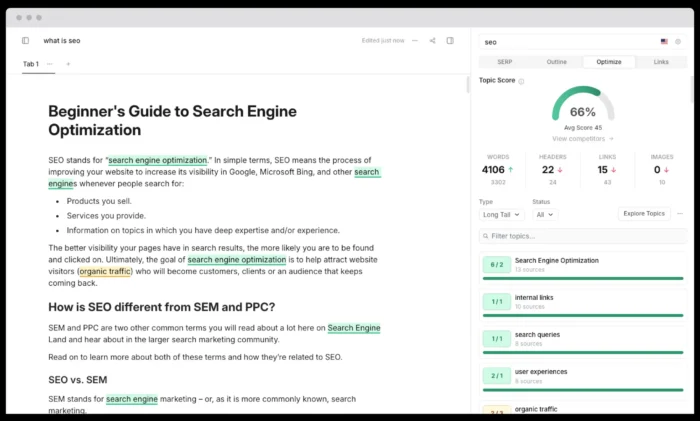
Recommendations can include adding keywords to your copy, increasing your word count, and improving readability.
Conducting A/B Testing
If you care about optimizing content for conversions, A/B testing will be an important part of your content optimization strategy.
I like to use A/B testing to try out different call to action designs, messages, and placements using a tool like Hotjar or Optimizely.

There are plenty of other on-page elements you can test, including:
- Titles and headings
- Images
- Layout
Note: this is an advanced strategy, and one I recommend you only start pursuing once you’ve fully optimized your content.
Continuously Refining and Updating Content
I’m sorry to say that content optimization never stops. Even for articles that you’ve already optimized. The truth is that Google updates its algorithm so often now that you can lose rankings in a heartbeat.
That means it’s important to stay on top of your content and rankings, optimizing articles again when necessary. Don’t obsess over content optimization, of course, and don’t neglect content creation. But do have a **** in your diary every three months or so when you check back over your content.
FAQs
SEO-optimized content is web content that has been carefully crafted to get higher search rankings.
SEO-optimized content includes relevant keywords and images, but it’s also content that loads quickly, is optimized for mobile devices, and attracts backlinks.
Content optimization in SEO is vital if you want to increase your website’s organic traffic since well-optimized content will rank higher in Google and other search engines.
But that’s not the only benefit. Content optimization also earns your website backlinks, builds trust, and increases the number of leads and conversions your site gets.
If you want to create SEO-optimized content, there are a couple of tips you should bear in mind when creating content.
These include adding keywords naturally throughout your piece and making sure they are present in your content’s headings, title tag, meta description and image alt tags.
You should also structure your content clearly, making it easy to understand and scan. Adding internal links as you write is also important if you want to create SEO-optimized content. The more you can add while writing, the less you’ll have to do when editing.
The result pages for almost every search term are incredibly competitive. So, the simple answer is that if you don’t optimize your content, you probably won’t rank. But content optimization can also make your copy more readable — even if you’re a really strong writer already — and help you convert more visitors.
You can use all the optimization strategies I’ve discussed in the above question, but if your content isn’t compelling, then it still may not rank. Compelling content encourages customers to take action, garners backlinks and social shares, and helps position your brand as an authority.
Luckily, there are several things you can do to create compelling content, including adding original research to your articles, interviewing experts, providing unique examples, and taking a controversial angle or unpopular opinion.
There are several things you should avoid doing at all costs when optimizing content. These include keyword stuffing (where you unnaturally add too many keywords to your copy), neglecting the user experience, prioritizing quantity over quality, and failing to optimize your site for mobile users.
Conclusion
Optimizing your content is essential if you want it to be read and drive conversions. A well-optimized mediocre article will always perform better than a poorly-optimized, well-written article.
So, optimize your content for the right keywords, use tools like Grammarly and Hemingway to improve your copy, and consider ways to measure and improve your copy’s conversion rate.
Do all three, and you’ll have a killer piece of content that ranks well, engages readers, and sells.
![YMYL Websites: SEO & EEAT Tips [Lumar Podcast] YMYL Websites: SEO & EEAT Tips [Lumar Podcast]](https://www.lumar.io/wp-content/uploads/2024/11/thumb-Lumar-HFD-Podcast-Episode-6-YMYL-Websites-SEO-EEAT-blue-1024x503.png)


